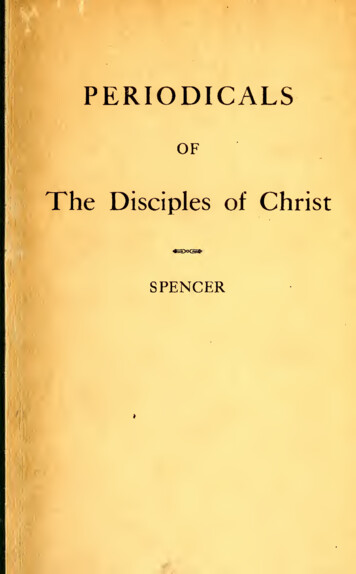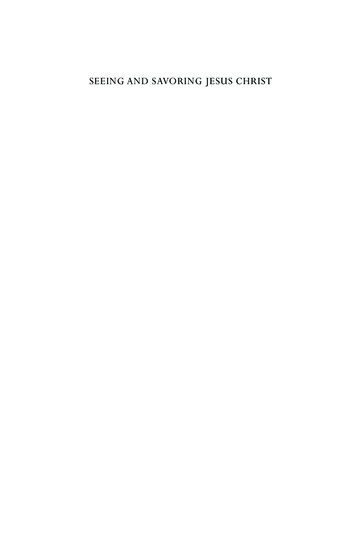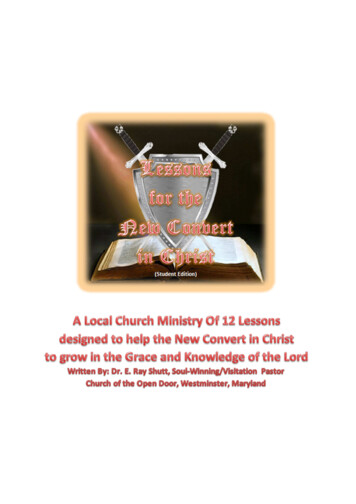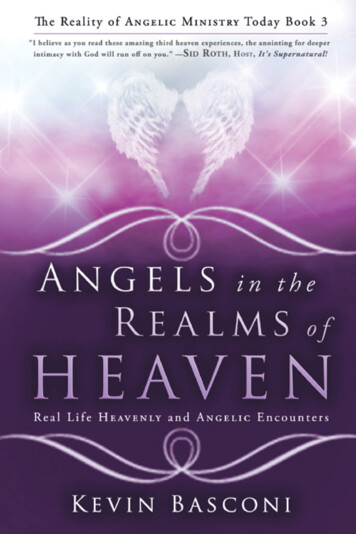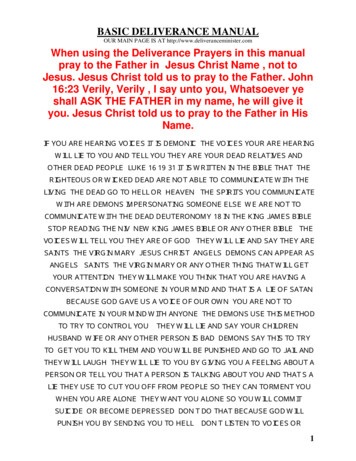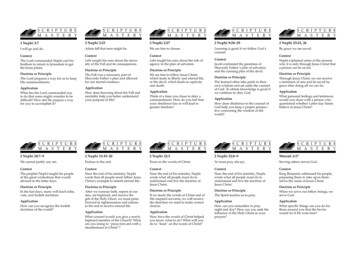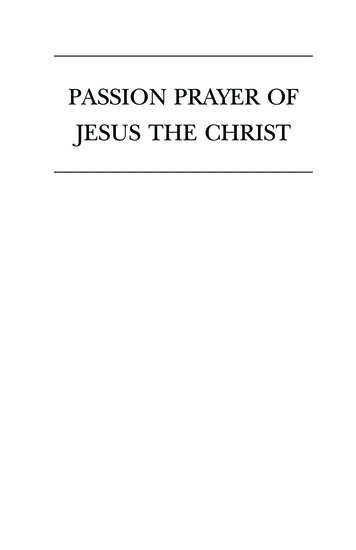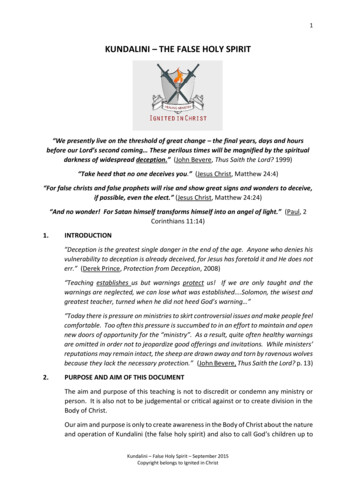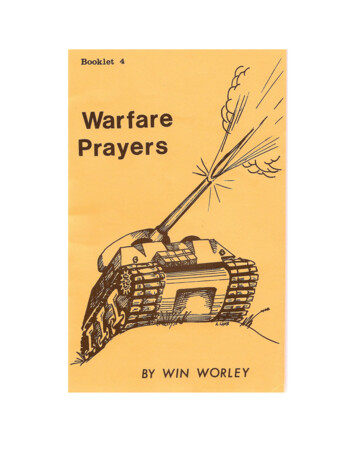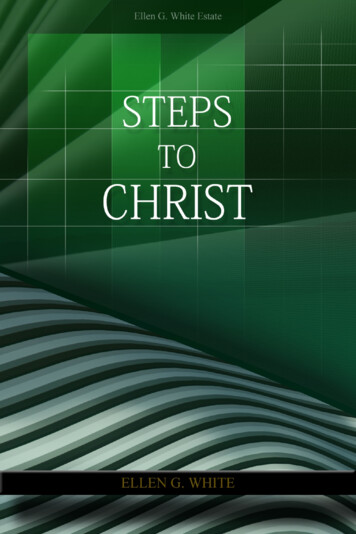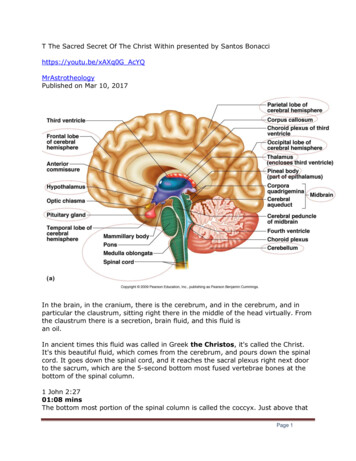
Transcription
Young 1Disciples of Christ and the University of Alabama School of Religion That Wasn’t, 1920-1935Prior to the 1966 formation of the Department of Religious Studies at the University ofAlabama, courses related to the study of religion were taught under the auspices of a Departmentof Religion staffed by clergy, primarily Protestant, from the Tuscaloosa area.1 The origins of thisstructure can be traced to the 1925 suggestion by a local Baptist minister to create a universityaffiliated “Bible Chair,” a program which would offer college credit for courses taught by areadenominational representatives.2 Such an arrangement had been pioneered by the Disciples ofChrist at the University of Michigan back in 1893,3 and the format had already spread tonumerous colleges and universities by the 1920s.4However, in 1920, members of the Disciples of Christ in Alabama had offered, and theUA Board of Trustees had accepted, an audacious proposal to create a fully Disciples-sponsored“University School of Religion”5 which, according to one laudatory newspaper article, wouldhave led to “a new era in combining theological seminaries with the advantages of a fully“Religious Studies: A Part of the Human Sciences,” Department of Religious Studies, University of Alabama,accessed March 9, 2021, part-of-the-human-sciences/.2Michael Cager Thomas, “Organized Religion at a State University: A Sociological Analysis” (MA thesis,University of Alabama, 1966), 39. See also Laura L. Savage, “From the Center to the Fringe: Religious StudentOrganizations Experience Change, 1945-2000,” in Voices From the Capstone: A Reflective History of the StudentExperience at the University of Alabama, 1945-2000, fromtheCapstone.pdf.3Rick Rowland, “The History of Campus Ministry in Churches of Christ,” in Ministering on the College Campus,eds. Tim Curtis and Mike Matheny (Nashville, TN: 20th Century Christian Foundation, 1991), 12.4Ronald Bruce Flowers, “The Bible Chair Movement in the Disciples of Christ Tradition: Attempts to TeachReligion in State Universities” (PhD diss., University of Iowa, 1967), 77. Flowers also helpfully defines a BibleChair as “an arrangement at a state university by which religion is taught by an instructor selected by the church and,usually, recognized by the university. Students take religion courses at the Bible Chair and the university grantscredit for them on the students’ degree programs.” See Flowers, “The Bible Chair Movement in the Disciples ofChrist Tradition,” 1.5The school was referred to by a handful of names during its gestation, including the “School of Religion atTuscaloosa,” as it appears in its one reference in D. Duane Cummins, The Disciples Colleges: A History (St. Louis:CBP Press, 1987), 109.1
Young 2equipped state university ”6 Yet as with many educational efforts in the cash-strapped region,7funding never fully materialized, and organizers ultimately shelved the project by the late 1920s.Adding insult to injury, the Disciples would later be denied from participating in UA’s BibleChair program in 1955,8 five years after First Christian Church of Tuscaloosa began its DisciplesStudent Fellowship.9Relying on contemporary periodicals, as well as a trio of unpublished or otherwiseobscure manuscripts10 on the history of the University of Alabama, this paper reconstructs thestory of the “University School of Religion” that wasn’t and explores the broader relationshipsbetween southern state universities and religious bodies in the early twentieth century. Theseconnections were forged in a climate of limited financial resources and of public suspiciontoward supposedly godless state universities.11 The solutions these universities developed often“University Opens Door To Churches For Join Work: Christian Denomination First In Cooperative MovementSchool As Adjunct: Seminary To Be Built On University Land: Theological Students To Take Regular AcademicCourses At State Institution,” Birmingham News, May 28, 1922.7For the story of a similarly-fated institution connected with Churches of Christ, see John Young, “Dixieland’sDemise: T.B. Larimore’s Dixieland College and the Tenuous Position of Christian Colleges within the Churches ofChrist,” Restoration Quarterly 58, no. 3 (2016): 143-159.8Thomas, “Organized Religion at a State University,” 46.9James B. Sellers, “History of the University of Alabama, Volume II: 1902-1957,” rev. and ed. W. Stanley Hoole(unpublished manuscript), James Benson Sellers manuscript, W.S. Hoole Special Collections Library, University ofAlabama, 508.10James B. Sellers originally composed “History of the University of Alabama, Volume II: 1902-1957” as a followup to the predecessor work, which was published as History of the University of Alabama Vol. 1, 1818-1902(Tuscaloosa, AL: University of Alabama Press, 1953), though the second volume remains unpublished in the W.S.Hoole Special Collections Library at the University of Alabama. Despite not being formally published, Sellers’ssecond volume was a key source for Michael Cager Thomas’s 1966 master’s thesis (already cited above) on the roleof organized religion at UA. Thomas’s thesis, in turn, served as a key reference for Laura L. Savage’s contribution(also previously cited) to the student-led research project Voices From the Capstone; Savage’s 2000 work focuseson the changes faced by religious student organizations on UA’s campus. Taken together, these three closely relatedmanuscripts give readers a relatively clear, if hard to track down, sense of how religious life changed at theuniversity across the entirety of the twentieth century. Yet none of the three mentions the proposed “UniversitySchool of Religion.”11Sellers, “History of the University of Alabama,” 497.6
Young 3reflected a remarkable amount of institutional flexibility and academic creativity—when they didnot run afoul of First Amendment prohibitions, that is.12The decades following the American Civil War, like most, if not all, were tumultuousones for state universities. Administrators often found themselves fending off criticisms fromstate officials who wanted to give them less money and from church officials who saw them ascorrosive to religious belief. As Frederick Rudolph observed in The American College andUniversity: A History, “Their dependence on legislative support exposed them to all thevicissitudes of politics [and] denominations regarded them as godless or as friendly to someother denomination.”13 Somewhat ironically, this denominational skepticism toward stateuniversities helped bring about a greater level of engagement by the churches in universityculture and student life to “compensate for the loss of religious vitality ”14Yet despite the very real challenges posed by the representatives of both church and state,American institutions of higher learning, including state universities, were growing by leaps andbounds as the nineteenth century rolled over into the twentieth. According to one reckoning,“while the nation’s population increased by 75 percent” in the earliest decades of the newcentury, “attendance at American colleges and universities skyrocketed an astounding 400For instance, the University of Texas suspended its connection to its Bible Chair program in 1987 after the state’sattorney general, Jim Mattox, issued legal opinions finding the arrangement unconstitutional. In part, one historiannotes, this was because “instructors were paid by religious organizations, while the university was granting credit forthe courses.” For more, see Rick Rowland, Campus Ministries: A Historical Study of Churches of Christ CampusMinistries and Selected College Ministries from 1706 to 1990 (Fort Worth, TX: Star Bible Publications, 1991), 5152.13Frederick Rudolph, The American College and University: A History (Athens, GA: University of Georgia Press,1990), 280.14Rudolph, The American College and University, 459. Rudolph adds that this engagement often took the forms of“the assignment of clergymen to work among college students, the growth of closer relationships between studentsand community churches, and the encouragement of denominational organizations in the colleges and universities.”12
Young 4percent.”15 The scope of American universities grew at a rate proportional to this spike inenrollment, as these institutions expanded to include more and more vocational and professionaleducational programs to meet the perceived needs of the workforce.16 In an appropriatelysweeping sentence, Rudolph writes thatThe American university, in one of its characteristic manifestations, thus becamea collection of postgraduate professional schools, schools which replaced theapprentice system in law, put responsibility into the study of medicine, tended torelegate theology into a separate corner, created education as an advanced field ofstudy, and responded—in one institution or another—to the felt necessities of thetime or the region, thus spawning appropriate schools at appropriate times,whether they were schools of business administration, forestry, journalism,veterinary medicine, social work, or Russian studies.17The University of Alabama felt each of these trends acutely. During the presidency ofGeorge H. “Mike” Denny (he of Bryant-Denny Stadium fame), the university expanded rapidlyin spite of the challenges it faced from state legislators and religious critics. When Denny tookover as president, UA employed a mere twenty-nine faculty members, only twelve of whom heldPhDs; two decades later, the faculty population had grown to 172.18 Denny also oversaw amassive campus building endeavor; out of the fifteen buildings which he proposed to UA’sBoard of Trustees in 1920, “the University managed to construct eleven [and] update two others”15David O. Levine, The American College and the Culture of Aspiration, 1915-1940 (Ithaca, NY: CornellUniversity Press, 1986), 68.16Levine, The American College and the Culture of Aspiration, 89.17Rudolph, The American College and University, 343.18Sellers, “History of the University of Alabama,” 45.
Young 5while substantially padding its endowment and implementing several new programs.19 To thatend, UA saw a significant expansion of its course offerings, largely through its extension but alsothrough the addition of “the School of Commerce and Business Administration, the School ofHome Economics, the School of Chemistry and the Graduate School.”20Again, all of this growth took place within a climate of relative hostility to the state’suniversities. Giving a sense of the picture’s bleakness, Wayne Flynt notes that “Not surprisingly,Alabamians traditionally spent as little on higher education as they did on public schools. In1918 Alabama ranked eleventh among 12 southern states on money expended for colleges.”21(Mercifully, at the behest of Governor Thomas E. Kilby, the state legislature boosted Alabama’seducational spending beginning the following year; “spending for education increased more than100 percent, rising from 3,750,000 in 1919 to 8,269,596 in 1922.”)22 Denny also had tonavigate a sizable controversy when a 1928 FTC investigation into utilities companiesdiscovered that the head of UA’s extension program, James S. Thomas, a member of theDisciples of Christ, received part of his salary from the Alabama Power Company. Althoughthere was no university policy precluding that arrangement, and while Denny supportedprofessors using their expertise in pursuit of statewide development, he did recommend to theBoard of Trustees that they establish a clearer policy on the matter going forward.2319Delbert Reed, Mike Denny: The Shadow of a Single Man (Tuscaloosa, AL: Paul W. Bryant Museum, 2016), 75.Reed, Mike Denny, 48. For visual evidence of the university’s growth during these years, see (literally) SuzanneRau Wolfe, The University of Alabama: A Pictorial History (Tuscaloosa, AL: University of Alabama Press, 1983),112 and following.21Wayne Flynt, Alabama in the Twentieth Century (Tuscaloosa, AL: University of Alabama Press, 2004), 237.22Michael A. Breedlove, “Thomas E. Kilby, 1919-1923,” in Samuel L. Webb and Margaret E. Armbrester, eds.,Alabama Governors: A Political History of the State, 2nd ed. (Tuscaloosa, AL: University of Alabama Press, 2014),195.23Leah Rawls Atkins, “Developed for the Service of Alabama”: The Centennial History of the Alabama PowerCompany, 1906-2006 (Birmingham, AL: Alabama Power Company, 2006), 156-157.20
Young 6Too, UA continued to be plagued by accusations of godlessness.24 As historian James B.Sellers noted in the unpublished second volume of his history of the university, “suchsuspicion was one of the factors which undermined University prestige in the late NineteenthCentury—and it remained for many years a bothersome undercurrent in the Twentieth.”25 Dennyhad faced a related challenge during his earlier tenure as the president of Washington and LeeUniversity, where he successfully outmaneuvered a group of trustees who, mostly for financialreasons, wanted to officially link the university to the Presbyterian Church.26 Likely on the basisof this prior experience, “Denny recognized early in his administration that only positive action”could clear the cloud of suspicion that hung over the school, opening the door for the Disciplesof Christ and other denominations to make inroads on the campus.27Despite a wider public disapproval of UA’s religious tenor, or perhaps because of thatdisapproval, the period was “one of extensive cooperation between University officials and thelocal churches of Tuscaloosa.”28 For the first time, a number of area congregations hired campusministers who could focus their efforts solely on university students. Too, at the suggestion ofDr. Joseph T. Boone of the First Baptist Church of Tuscaloosa, a Bible Chair program wasestablished which allowed, at first, three denominational representatives to teach classes for UAcredit. These ministers—growing in number to seven by 195329 and eight by 195530—constitutedthe earliest version of UA’s Department of Religion, one of several “strong, semi-vocational24For their part, as Wayne Flynt reminds us, leaders of state universities often looked with suspicion upondenominational colleges and their “classical curricula,” which they saw as “symbolic of impractical, elitist, isolatedcolleges.” See Flynt, Alabama in the Twentieth Century, 237.25Sellers, “History of the University of Alabama,” 497.26Reed, Mike Denny, 17-18.27Sellers, “History of the University of Alabama,” 497.28Thomas, “Organized Religion at the State University,” 39.29Sellers, “History of the University of Alabama,” 499.30Savage, “From the Center to the Fringe,” 221.
Young 7courses designed to prepare young men and young women for useful and interesting careers.”31Boone’s 1925 proposal of the Bible Chair program and its implementation in 1927,32 then,proved to be significant turning points in the history of religious instruction at the University ofAlabama. Russell T. McCutcheon adds in his history of the modern UA Department of ReligiousStudies that while “the current department developed from various antecedents that do not muchresemble what we today call comparative religion, the history of religions, or simply religiousstudies,” the scope of the earlier program was impressive, especially considering “the voluntarynature of the instructors staffing these courses ”33But even though the origins of UA’s Bible Chair program,34 its transformation into aDepartment of Religion, and its eventual replacement by a Department of Religious Studies arestories which have all been told before, one sizable wrinkle which has generally been overlookedis that Boone was not the first minister to propose a denominationally-supported program ofreligious instruction at the University of Alabama, nor was his proposal the first to be acceptedby UA’s Board of Trustees. Both of these honors go instead to the Disciples-sponsored“University School of Religion,” a project supported most strongly by Alabama Disciple OscarPendleton (O.P.) Spiegel.Spiegel’s school-to-be has left very little impact on the history of Disciples educationalefforts, or on the history of the Disciples in Alabama. Disciples historian D. Duane CumminsSellers, “History of the University of Alabama,” 162. Sellers lists five “of sufficient uniqueness to deserve specialconsideration—music, journalism, speech, radio, and religion.”32Sellers, “History of the University of Alabama,” 499.33Russell T. McCutcheon, “Afterword: Reinventing the Study of Religion in Alabama,” in Writing Religion: TheCase for the Critical Study of Religion, ed. Steven W. Ramey (Tuscaloosa, AL: University of Alabama Press, 2015),213. McCutcheon’s entire essay (p. 208-222) is worthwhile reading for those seeking to understand the history ofreligious study and instruction, variously defined, at the University of Alabama across the decades.34For more on the involvement of Churches of Christ in UA’s Bible Chair program, see Rowland, CampusMinistries, 35-37.31
Young 8refers only once to the “School of Religion at Tuscaloosa” in The Disciples Colleges: A History,where he provides a concise chart of church membership and economic statistics for the regionsrepresented by various Disciples schools in 1926.35 George H. Watson and Mildred B. Watsondevote about a page to the school in their History of the Christian Churches in the AlabamaArea, where they lament that “There is no way to estimate the impact that such a school mighthave made upon churches of the area. Its students could have served struggling churches and itsgraduates been equipped for the larger pulpits.”36 Aside from these brief references, though, thestory of the University School of Religion has, to date, remained confined to the primary sources.The core of the school’s story begins with the 1866 birth of its greatest champion, O.P.Spiegel, who hailed from the area outside of Falkville, Alabama, and who attended T.B.Larimore’s Mars Hill College in his youth. Spiegel continued his education at the College of theBible, Kentucky University,37 and the University of Chicago.38 He was the second of threebrothers who would all play major roles in the history of Alabama Disciples, with older brotherJ.E. holding various pastorates throughout the southeast and editing the Alabama Christian, andyounger brother S.P. serving as State Evangelist and sponsor of the Alabama Young People’sConference.39 For his part, O.P. likewise served as State Evangelist, held several ministerialpositions in Alabama and Georgia, and edited both the Gospel Messenger and the Alabama35Cummins, The Disciples Colleges, 109.George H. Watson and Mildred B. Watson, History of the Christian Churches in the Alabama Area (St. Louis:Bethany Press, 1965), 117.37The predecessor of Transylvania University, not the University of Kentucky.38Donald Alfred Nunnelly, “The Disciples of Christ in Alabama, 1860-1910” (BDiv thesis, The College of theBible, 1954), 138. For more on Mars Hill College, see Young, “Dixieland’s Demise,” 150. Based on his ruralupbringing and wide-ranging educational path, Spiegel himself nearly embodied singlehandedly the scope of DavidEdwin Harrell Jr.’s observation that “Disciples religion and Disciples social thought were as different as were‘peckerwood’ sharecroppers in Alabama and sophisticated professors at the University of Chicago.” See DavidEdwin Harrell Jr., A Social History of the Disciples of Christ, vol. 2, Sources of Division in the Disciples of Christ,1865-1900, 2003 ed. (Tuscaloosa, AL: University of Alabama Press, 2003), 350.39Nunnelly, “The Disciples of Christ in Alabama,” 137, 139.36
Young 9Christian.40 O.P. married Anne Brawner Widener of Franklin, Kentucky, in 1893, and eventuallypassed away in early 1947, preceded in death by both of his brothers and his wife.41 Spiegel isremembered (or misremembered, as Chris Cotten has compe
Alabama, 508. 10 James B. Sellers originally composed “History of the University of Alabama, Volume II: 1902-1957” as a follow-up to the predecessor work, which was published as History of the University of Alabama Vol. 1, 1818-1902 (Tuscaloosa, AL: University of Alabama Press, 1953), though the second volume remains unpublished in the W.S.
